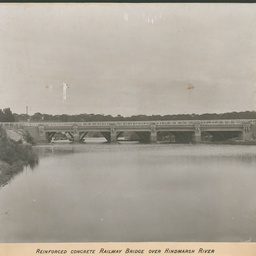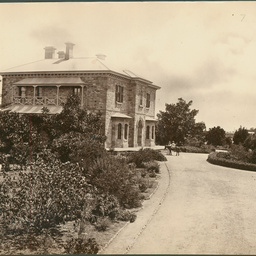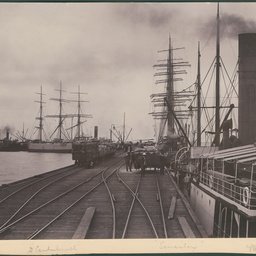Find • 1907 • Results 781 to 810 of 2,044


Opening of Town Hall
Opening of the new Town Hall, Unley.


Bank of Adelaide, Unley
Bank of Adelaide, Unley.


Unley Hockey club
Unley Hockey club.


Railway Bridge
Railway Bridge over Hindmarsh River, Victor Harbor.


Victor Harbor school children
Students of the Victor Harbor public school, Torrens Street, Victor Harbor, in Japanese costume. Left to Right: Neta Grosvenor, ?, Fred Wilton, William 'Bill' Holliday, Esther Wallage, Kate Shannon, Roy Nurton, Nell Gribble, Allan Taylor, Clarice Miller, ?, ?, Elsie Wilton,Elizabeth 'Bessie' Morris, Tom Battye, Naomi Chillingworth, Florence Weymouth, William 'Bill' Taylor, ?, Eddie Honeyman, Ida Hill, Lucy Whiting, Percy Field, Winnie Chick, Belle Whiting, Roy Bolger, Louie Croucher, Clair Adey.


Hindmarsh Valley Road
Hindmarsh Valley Road, Victor Harbor. Also hold a coloured version of this image as a postcard.


Veteran Cars, Victor Harbor
Veteran Cars at Victor Harbor. 'Early Motoring Portraits' has a page showing the family of A.J.Humberstone of Victor Harbor in a 1903 8 hp single cylinder Darracq. The 1907 12hp two cylinder Darracq (shown) replaced the earlier car. The other car is Humberstone's who owned the one above. The Car with plate No. 71 is a 12hp two cylinder Darracq, owned by A J Humberstone of Victor Harbor. The car with plate No. 775 is a 1909 15hp Deasy, seen in the photo driven by Daniel Cudmore's son Paul. Information courtesy of the Veteran Car Club of SA.


The Breakwater, Victor Harbor
The Breakwater, Victor Harbor.


Victor Harbor
Victor Harbor and Granite Island.


"Waikerie", River Steamer
River steamer "Waikerie" at Waikerie settlement. The steamer was built by Captain Albert Francis. It was owned by William Tinks from 1911-1926. Waikerie began as a village settlement in 1894 as part of the government scheme to open up the land along the River Murray. Bill (William) Tinks in partnership with Albert (Bert) Francis sold "Waikerie" to W & WF Bailey in 1926


Residence of John Acraman
Residence of John Acraman of Walkerville. A note on the back of the photograph states "Note supplied by the Assistant District Clerk, District of Walkerville (15/11/1941) - It [building] is shown in our records as being in View Road, Walkerville, though the address used by owner is North East Road. A verandah and balcony have been added to the front of the dwelling, otherwise the present appearance (1941) is very little changed from the photograph, and it is in a good state of preservation". There is also a hand drawn map of the location of the house on the back of the photograph. John Acraman was a prominent businessman in the colony of South Australia. He had diverse business interests including coastal and River Murray shipping, insurance, pastoral management, agents for Guinness Stout. He was a keen sportsman, on the Board of Governors of St Peter's College, collector of fine arts and one of the oldest members of the Adelaide Club. He is remembered as being the father of South Australian football after he introduced the Victorian game to South Australia. The home of the Acramans called "The Grove" at Walkerville was destroyed by fire in 1876.


Wallaroo Boat Harbour
Wallaroo Boat Harbour. The settlement of Wallaroo was built around Wallaroo Bay and a jetty was built in 1861 to enable ships to bring mining equipment for the mines being established at Kadina. Although the mines were named Wallaroo Mines they were located at Kadina. Wallaroo was a smelting and habour town. This photograph shows boats anchored in Wallaroo Harbour during rough weather.


Wallaroo Jetty
[General description] A busy scene of shipping, both sail and steam, moored at Wallaroo Jetty. Horse drawn rail wagons haul bags of grain to be loaded onto the ships whilst passengers wait to board. On the left is the 3 masted ship 'Cambuskenneth', registered in Tvedestrand, Sweden, owned at this time by Alex Bech & Co. This ship was subsequently sunk on 29 June 1915 by German submarine U-39. [On back of photograph] 'Wallaroo Jetty / 1907-12 / *1905-10 see letter D.M. Fyfe 1971 / Wallaroo National Trust'.


Wallaroo Jetty
[General description] Shipping, both sail and steam moored at Wallaroo Jetty where grain bags await loading onto cargo ships. In the foreground the rail lines for wagons can be seen. The ship in the centre-right is the four masted iron barque 'Samaritan'. On the left the three masted ship is the 'Cambuskenneth' and the steamer behind it is the SS 'Investigator'.


Wallaroo Jetty
[General description] Shipping moored at Wallaroo Jetty, seen from the rocky shore. The large four masted vessel on the right is the 'Samaritan', an iron barque. The three masted ship is the 'Cambuskenneth' and the steamer on the left is the SS 'Investigator'.


Presbyterian church, Wallaroo
Presbyterian Church, Wallaroo. The foundation stone for St Andrews Presbyterian Church was laid in September 1864 by the Reverend Ralph Drummond. The Italian Gothic style church was opened a year later


Wallaroo Phospate Co
Wallaroo Phosphate Company Ltd. Phosphate rock for fertiliser was manufactured at Wallaroo from 1900. It was one of the largest inward cargoes. It was used for the local farms. It was situated near Charles Terrace


Wallaroo
Wallaroo Township showing shops along Cornish Terrace. Some of the shops include George E Pritchards, Stationery shop, Tonkins, Clayton Brothers Tea Rooms, Hockings Drapery,


Wallaroo Town Hall
Wallaroo Town Hall was built in 1902 and destroyed by fire in 1917. It was rebuilt in 1918 and a memorial arch was erected in front of the Town Hall to honour the men from the town who lost their lives in World War I


Wallaroo Smelters
Wallaroo Smelters were constructed in 1861 by the owners of the Wallaroo Mine to process the ore from there and from the Moonta Mine. The smelting works were at one time the largest smelter outside Swansea in Wales. The mines and smelters were closed down in 1923.


Post Office, Wallaroo
Post Office, Wallaroo. Postal facilities were initially operated from the general store but in 1865 the Post and Telegraph Office was opened. The new Post Office opened in 1910 is shown in this photograph


Office and Taylor's Shafts
Office and Taylor's Shafts, Wallaroo Mines.


St. Mary's Church of England
St. Mary's Church of England, Watervale. Watervale sits in the Clare Valley in South Australia. The church was built by B Meller of Auburn in 1907 of local stone.


Jack Chapman
Jack Chapman at Speedway Royal, Wayville.


Jack Chapman
Jack Chapman at Speedway Royal, Wayville.


Jack Chapman
Jack Chapman at Speedway Royal, Wayville.


Jack Chapman
Jack Chapman on a 31/2 AJS at Speedway Royal, Wayville.


Jack Chapman
Jack Chapman at Speedway Royal, Wayville.


Motorcyclists at Wayville
F. Duckett, Jack Chapman at Speedway Royal, Wayville.


Motorcyclists at Wayville
Harry Butler and Jack Chapman at Speedway Royal, Wayville.
